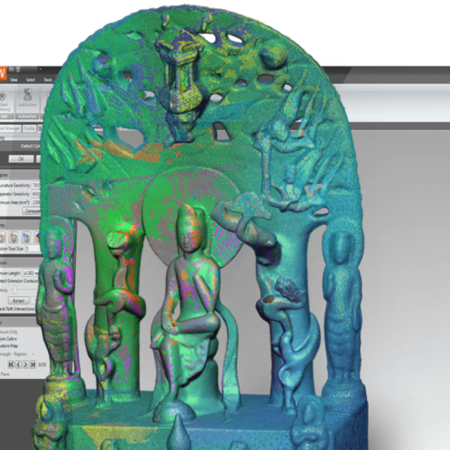Developing new ways to manufacture surf boards and kayaks using 3D scanning and Geomagic Wrap scan modeling software
Surfing has probably been around as long as there have been waves to max and surf to shred. Physical evidence of the board’s existence predates 500 AD with some of the earliest “sticks” made from hulled out trees. The boards of today are only a little more dignified, some still hand cut from balsa wood while others are created from epoxy poured between handcrafted wooden molds. Not since the implementation and marriage of scanning with CAD technology has the craft been brought into a whole new realm of capabilities.
(Image 1 below - a close up of the original scan data)
John Kaprocki owner of Ocean Blue Woodworks near Daytona Beach, Fla. is developing a “Waveski” for the disabled and handicapped. They are even seeking a grant to achieve the goal: “Everybody on the Water World Wide”. The difference between regular surfing and “wave skiing” is that in the latter, the rider can remain seated on the board. Typically a surfboard is handmade from a 2-inch foam panel which requires a time-consuming and labor-intensive carving process, but this particular project required a totally different approach altogether.
Kaprocki made the decision to outsource the scanning to NeoMetrix Technologies out of Lake Mary, Fla. In business since 2003, NeoMetrix specializes in the application of laser-based 3D measurement equipment for digitizing, reverse engineering, and computer-aided inspection. NeoMetrix also offers complex part measurement, reverse engineering inspection, and rapid prototyping all with the mantra of “no project is too big or too small”.
(Image 2, below. Initial 3D 'wrap' data in Geomagic Wrap)
Dan Perreault, the president of NeoMetrix, was more than prepared for Ocean Blue’s project. “We are a service provider and currently represent FARO®, Konica Minolta, Steinbichler, Creaform, Objet 3D printers and Geomagic software. We only represent products that we believe in and are proud of. We sell what we use and use what we sell, so when I look for a new business relationship, I look for a technology that we can utilize in our service business. This allows us to sell with confidence, particularly on the scanning side of our business. Every sale is a ‘proof of concept’ in which we’ve got to show the customer where the technology is going to work for their application, and that we have the skill set to support them as they move forward with the technology. As a result of our offerings, we are often approached by customers that have a one-time project for which they are not in a position to invest 50 or 100 thousand dollars for a ‘scanning solution’.”
(Image 3. Surface data of the kayak model)
The procedure itself was very simple said, Perreault. “We used the arm-free handheld Creaform MetraSCAN™ because of the accuracy of the system and the size of the part. What’s great is that the scanner is able to apply an optical tracking system to position itself in space. Since the board was considered a larger object, we had to scan it in different positions then flip it over. We ended up with three data sets from the different scanning positions. STL files generated in Creaform’s VX Elements were then imported into Geomagic Wrap. From there they aligned and cleaned up. Finally, we established a plane of symmetry, cut it in half and mirrored it.”
In the past, the customer would have had to build a silicone mold around the original which would result in an accurate representation but unfortunately with all of the defects from the original. “The benefit of scanning is that now we can accurately duplicate the original, remove any imperfections and thus improve the design. As a result of this technology, a durable master mold derived from a scan of the improved product can be machined. An added benefit is that this procedure allows for the capability to mass produce the board.”
Perreault noted the minimal time investment. “Scanning took maybe a couple of hours with setup and everything else, and then it was no more than two hours to finish the CAD model with Geomagic Wrap. So the whole thing soup to nuts was half a day. This is absolutely the fastest way to get the project done.”
Kaprocki added “I just took the IGES model, pulled it right into Catia and machined the mold. With this process, it only took 12 minutes to make a surfboard.”
